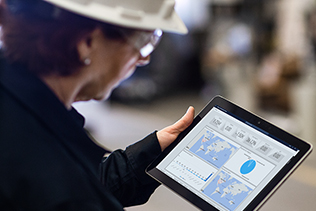Engineering Safety at work
How the Kuwait Gulf Oil Company is keeping its staff safe from COVID-19.


Safety comes first in the oil and gas industries. So, when the pandemic arrived, the Kuwait Gulf Oil Company (KGOC) team knew they needed a mechanism for keeping its workers safe. The alternative was halting production – which could have disastrous effects on the global economy.

The challenge was two-fold: First, ensuring everybody at work was healthy. Second, keeping track of any infections to head off any potential outbreaks.
In an impressive display of engineering ingenuity, KGOC created a solution within a week simply by using Microsoft software they already had to hand.
“The first came with lockdown when both Kuwait and Saudi Arabia closed their borders. Many of our teams used to travel between the two countries every day, but this was now impossible.”
Cross-border isolation
KGOC manages Kuwait’s share of the natural gas and oil deposits in the divided zone straddling its border with Saudi Arabia.
“The COVID-19 pandemic created two major challenges,” explains Ahmad Abdulla Safar, Team Leader of Information Technology at KGOC. “The first came with lockdown when both Kuwait and Saudi Arabia closed their borders. Many of our teams used to travel between the two countries every day, but this was now impossible.”


With staff suddenly isolated and spread out, KGOC realized they needed a way to keep track of workers’ health remotely, ensuring the business could account for sick leave, provide support where necessary, and keep the business running smoothly.
Using Microsoft SharePoint, KGOC created a website for employees to update their health status every day. This data was fed into a Microsoft Power BI analytics dashboard, providing an up-to-date snapshot of employee health. Impressively, Safar says, “Developing and deploying the system took us only a week, including user training.”
A safe return to work
As restrictions eased and employees began returning to the workplace, KGOC had another problem on their hands: How to ensure How to quickly and safely contain any outbreaks.
“With Power BI, we have the ability to connect different data sources from any platform. For example, COVID-19 data will be inserted through the SharePoint input form. Building occupancy data is fetched from our attendance system and gate pass system,” explains Safar.
If an infection was confirmed, KGOC could use this system to trace where the employee had been, when, and who they may have had contact with – enabling the company to intervene, stemming the spread of the virus quickly.
And as Saudi and Kuwaiti vaccination programs have progressed, KGOC has added vaccine progress to its SharePoint data to better understand who is most at risk and when the chances of transmission are lower.
With the system fully developed, “We can visualize daily, weekly, cumulated statistics at a very granular level,” says Safar. “Confirmed cases, attendance, and occupancy levels are broken down by region and nationality to build a holistic and very up-to-date picture of the safety of our operations in both Saudi Arabia and Kuwait. This helped us build our business continuity plan in a comprehensive way.”

Proactive continuity
KGOC’s proactivity and speed in which it was able to protect its employees’ health is impressive.
But perhaps the most surprising part of the initiative is that it required no new technology. The final solution was an elegant adaptation of Microsoft tools already at its disposal.
For a business brimming with engineers, perhaps this shouldn’t come as a surprise. But it demonstrates the power that digital tools like Microsoft SharePoint and Power BI can have in the right hands.
Microsoft helps businesses on their digital transformation journeys. Discover more.














































